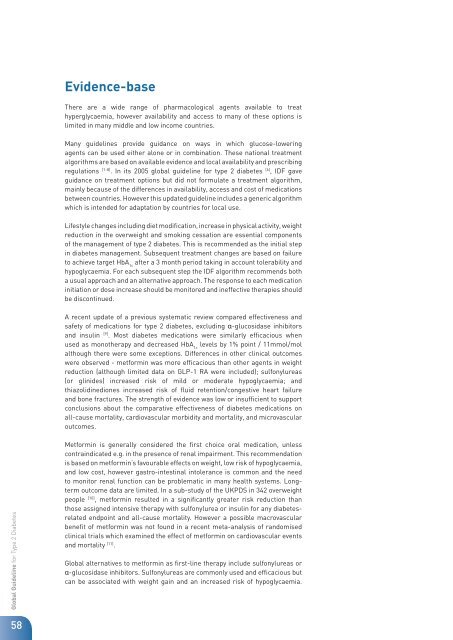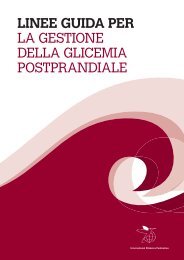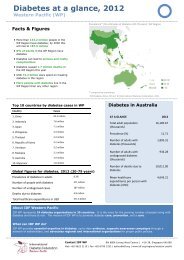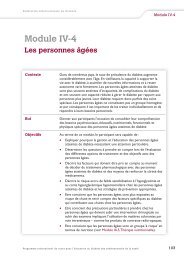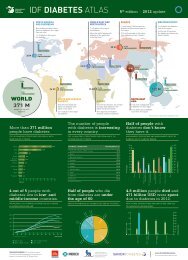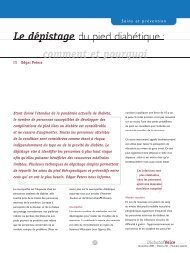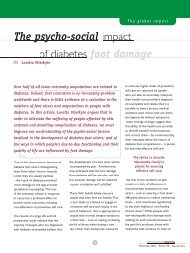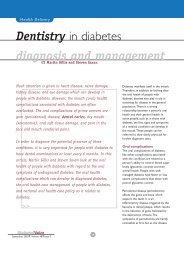Evidence-base - International Diabetes Federation
Evidence-base - International Diabetes Federation
Evidence-base - International Diabetes Federation
Create successful ePaper yourself
Turn your PDF publications into a flip-book with our unique Google optimized e-Paper software.
Global Guideline for Type 2 <strong>Diabetes</strong><br />
58<br />
<strong>Evidence</strong>-<strong>base</strong><br />
There are a wide range of pharmacological agents available to treat<br />
hyperglycaemia, however availability and access to many of these options is<br />
limited in many middle and low income countries.<br />
Many guidelines provide guidance on ways in which glucose-lowering<br />
agents can be used either alone or in combination. These national treatment<br />
algorithms are <strong>base</strong>d on available evidence and local availability and prescribing<br />
regulations [1-8] . In its 2005 global guideline for type 2 diabetes [6] , IDF gave<br />
guidance on treatment options but did not formulate a treatment algorithm,<br />
mainly because of the differences in availability, access and cost of medications<br />
between countries. However this updated guideline includes a generic algorithm<br />
which is intended for adaptation by countries for local use.<br />
Lifestyle changes including diet modification, increase in physical activity, weight<br />
reduction in the overweight and smoking cessation are essential components<br />
of the management of type 2 diabetes. This is recommended as the initial step<br />
in diabetes management. Subsequent treatment changes are <strong>base</strong>d on failure<br />
to achieve target HbA 1c after a 3 month period taking in account tolerability and<br />
hypoglycaemia. For each subsequent step the IDF algorithm recommends both<br />
a usual approach and an alternative approach. The response to each medication<br />
initiation or dose increase should be monitored and ineffective therapies should<br />
be discontinued.<br />
A recent update of a previous systematic review compared effectiveness and<br />
safety of medications for type 2 diabetes, excluding α-glucosidase inhibitors<br />
and insulin [9] . Most diabetes medications were similarly efficacious when<br />
used as monotherapy and decreased HbA 1c levels by 1% point / 11mmol/mol<br />
although there were some exceptions. Differences in other clinical outcomes<br />
were observed - metformin was more efficacious than other agents in weight<br />
reduction (although limited data on GLP-1 RA were included); sulfonylureas<br />
(or glinides) increased risk of mild or moderate hypoglycaemia; and<br />
thiazolidinediones increased risk of fluid retention/congestive heart failure<br />
and bone fractures. The strength of evidence was low or insufficient to support<br />
conclusions about the comparative effectiveness of diabetes medications on<br />
all-cause mortality, cardiovascular morbidity and mortality, and microvascular<br />
outcomes.<br />
Metformin is generally considered the first choice oral medication, unless<br />
contraindicated e.g. in the presence of renal impairment. This recommendation<br />
is <strong>base</strong>d on metformin’s favourable effects on weight, low risk of hypoglycaemia,<br />
and low cost, however gastro-intestinal intolerance is common and the need<br />
to monitor renal function can be problematic in many health systems. Longterm<br />
outcome data are limited. In a sub-study of the UKPDS in 342 overweight<br />
people [10] , metformin resulted in a significantly greater risk reduction than<br />
those assigned intensive therapy with sulfonylurea or insulin for any diabetesrelated<br />
endpoint and all-cause mortality. However a possible macrovascular<br />
benefit of metformin was not found in a recent meta-analysis of randomised<br />
clinical trials which examined the effect of metformin on cardiovascular events<br />
and mortality [11] .<br />
Global alternatives to metformin as first-line therapy include sulfonylureas or<br />
α-glucosidase inhibitors. Sulfonylureas are commonly used and efficacious but<br />
can be associated with weight gain and an increased risk of hypoglycaemia.


